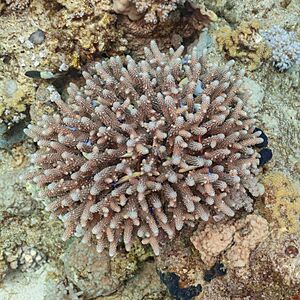Acropora hemprichii facts for kids
Quick facts for kids Acropora hemprichii |
|
|---|---|
 |
|
| Conservation status | |
| Scientific classification | |
| Synonyms | |
|
Acropora hemprichii is a type of coral that lives in the ocean. It was first described by a scientist named Christian Gottfried Ehrenberg in 1834. This coral lives in coral reefs, usually between 3 and 15 meters (about 10 to 50 feet) deep. It can live for 13 to 24 years.
Scientists have listed Acropora hemprichii as a vulnerable species. This means its population is decreasing, and it needs protection. It is found in many places and is also listed under CITES Appendix II, which helps control trade of endangered species.
What Does It Look Like?
Acropora hemprichii corals live together in large groups called colonies. These colonies have many branches that are packed closely. The branches can be flat or point upwards. Each branch can grow to be about 12 to 30 millimeters (about 0.5 to 1.2 inches) wide and around 80 millimeters (about 3 inches) long.
Sometimes, these coral colonies can grow very wide, even more than 2 meters (about 6.5 feet) across. They can form their own large areas on the reef. The coral has small, rounded structures called axial corallites. These are like tiny domes. Other parts, called radial corallites, are cone-shaped and have smooth walls. The coral's skeleton, called the coenosteum, is smooth. This coral is usually brown or pink-brown in color. Its skeleton is made of aragonite, a strong mineral.
Where Does It Live?
Acropora hemprichii is common in certain areas, but its overall range is small. You can find it in the Gulf of Aden, the Red Sea, the Philippines, and parts of the Indian Ocean.
Sadly, corals can be affected by something called coral bleaching. This happens when the water gets too warm, and the coral loses its color and food source. In the northern Red Sea, this coral has been lucky. Only about 6% of its reefs there have been destroyed by bleaching. However, in the southern Red Sea, the coral has not survived as well.
Scientists believe this coral first appeared a very long time ago, between 0.78 and 0.13 million years ago.
Why Is It Important?
Even though this coral is common in some areas, its total population is believed to be shrinking. Many things threaten Acropora hemprichii. These include diseases, bleaching caused by rising sea temperatures, and problems from fishing. Human activities and buildings near the coast can also harm them.
Also, a type of starfish called Acanthaster planci (often called the Crown-of-Thorns starfish) eats this coral. Because of these threats, Acropora hemprichii is listed as vulnerable on the IUCN Red List. It is also on CITES Appendix II, which means its trade is controlled to help protect it.
How Was It Discovered?
The Acropora hemprichii coral was first described in 1834 by Christian Gottfried Ehrenberg. He first named it Heteropora hemprichii. Later, it was re-classified and given its current name, Acropora hemprichii.


